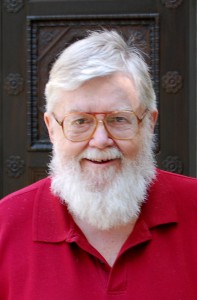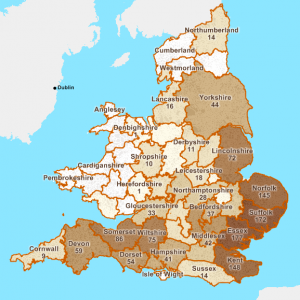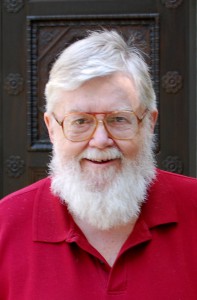 In early 2015 I had just completed work on The Great Migration Directory: Immigrants to New England, 1620-1640, with abbreviated entries for each known head of household or isolated individual participant in the Great Migration. The result was an alphabetical listing of about 5,700 families or individuals. Each entry included last name, first name, English origin, year of migration, first residence in New England, and a brief listing of the best primary and secondary sources available for each. For about 1,800 of the entries, the English origin (defined as the last known residence in England before migration) was known.
In early 2015 I had just completed work on The Great Migration Directory: Immigrants to New England, 1620-1640, with abbreviated entries for each known head of household or isolated individual participant in the Great Migration. The result was an alphabetical listing of about 5,700 families or individuals. Each entry included last name, first name, English origin, year of migration, first residence in New England, and a brief listing of the best primary and secondary sources available for each. For about 1,800 of the entries, the English origin (defined as the last known residence in England before migration) was known.
Shortly after this work was finished, but before the book had been printed, I led a Great Migration tour to England. We spent the bulk of our time in Hampshire and Wiltshire, visiting a number of places associated with the ministers Robert Parker and Stephen Bachiler, and the migrating families attached to these two men. This tour in mid-2015 was unlike early Great Migration tours in that we travelled to England as a group on the Queen Mary II. On most days during the cruise Brenton Simons and I each gave a morning lecture, and I used one of my talks to discuss known migrations from each English county. Assisted by Ginevra Morse, I created for this lecture a series of maps showing the concentrations of emigrants from each county.
During the talk I mentioned briefly that it had long been my dream to create an interactive online map to portray the migration process.
During the talk I mentioned briefly that it had long been my dream to create an interactive online map to portray the migration process. At the end of that talk, Peter Van Demark – NEHGS member, regular tour participant, and, most importantly for this purpose, professional computer cartographer – came up to me and said that if I was serious about such a map, he would be glad to work with me. And so a four-year project was born.
To create the desired map, we needed three elements: two databases and a user interface to connect them. I created a crude version of what we called the origins database, by abstracting from The Great Migration Directory the last name, first name, year of migration, English origin, and first New England residence for each of the 1,800 entries for which the English origin was known. The second database we required was an electronic file of county and parish boundaries for England. The most useful one we could find was a map of these boundaries as of about 1851, for which we quickly obtained a license. With some assistance from me, Peter was able to massage many of the boundaries and place names so that they reflected the England of about 1630. Finally, Peter and his colleague Giovanni Flammia built an interface that would allow users to query the databases by name or by parish.
 The resulting application is now available through AmericanAncestors.org.
The resulting application is now available through AmericanAncestors.org.
We hope this map will give you a more dynamic view of your ancestor’s migration and will also provide you with clues for further research. And I have no doubt that many of you will find uses for this application that we have not dreamed of. In time, we will be updating the origins table with new information, and adding other features that should make this an even more useful tool.
Share this:

About Robert Charles Anderson
Robert Charles Anderson, Director of the Great Migration Study Project, was educated as a biochemist and served in the United States Army in electronics intelligence. In 1972 he discovered his early New England ancestry and thereafter devoted his time and energies to genealogical research. He published his first genealogical article in 1976, and about the same time began to plan for what eventually became the Great Migration Study Project. In 1983 he received a Master’s degree in colonial American History from the University of Massachusetts at Amherst. Anderson was elected a Fellow of the American Society of Genealogists in 1978 and has served as Secretary and President of that organization. He became a Contributing Editor of The American Genealogist in 1979, Associate Editor in 1985 and Coeditor in 1993. He has been an editorial consultant to the New England Historical and Genealogical Register since 1989.View all posts by Robert Charles Anderson →